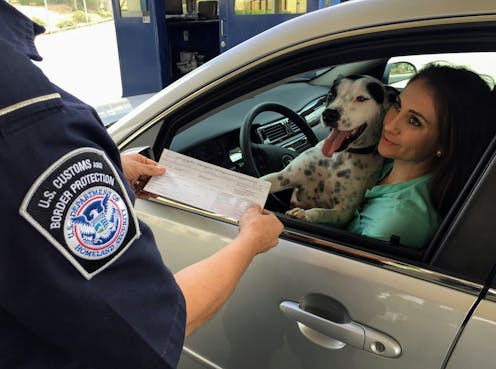
The U.S. Centers for Disease Control and Prevention (CDC) is implementing new border rules for dogs entering the United States as of Aug. 1. However, the new rules going into effect are not as onerous as the ones originally planned.
The previously proposed rules required that dogs travelling to the U.S. from Canada be accompanied by an onerous CDC Dog Import Form validated by a veterinarian before each visit into the United States. This was in addition to requirements that the dog:
- be at least six months old
- have an ISO-compatible microchip
- appear healthy upon arrival
The requirement for veterinary confirmation sparked significant controversy, especially among American and Canadian politicians and pet owners who claimed it would place a disproportionate burden on travellers and border patrol services.
The CDC has recently revised these proposed rules, now requiring only a simple form for entry from rabies-free countries such as Canada, and no longer requiring veterinarian validation. However, stricter requirements may only have been put on hold for nine months while the agency reviews alternative options.

The regulations aim to prevent rabies from entering the United States, where canine rabies has been eliminated for some time. The majority of remaining rabies cases — over 90 per cent — are associated with wildlife, not household pets.
Prior to Aug. 1, the CDC only required that dogs appear healthy, and that you “provide a written or verbal statement your dog has NOT been in a high-risk country for rabies within the past 6 months or since birth if under 6 months of age.”
Impact on pet owners and care providers
The back-and-forth over these changes highlights the importance of considering the broad impacts of such regulations on the well-being of pets and people. As researchers who work at the interface of human, animal and environmental health (called One Health), we are concerned about reactive policies that do not consider the broad impacts of such programs, and hope the revised rules will be maintained.
New regulations must consider more than just disease. Research shows that pets can be crucial for people’s health and well-being, providing companionship that helps reduce loneliness and social isolation. These benefits are vital for mental and physical health, as loneliness has health impacts equivalent to smoking 15 cigarettes a day.
For many, pets are family members offering comfort, especially during tough times. Policies restricting travel or access to veterinary care undermine and devalue these crucial bonds.
Such rules must also consider impacts on people with disabilities who rely on service animals. These individuals depend on service dogs for daily assistance and independence. Barriers to travel or re-entry into the U.S. can disrupt this critical support.
As well, regulations that require veterinary reporting on rabies vaccination place a significant workload on veterinarians, as pointed out by the Canadian Veterinary Medical Association. By requiring additional paperwork, an already overworked veterinary medical system will face further strains.
Impact on pets
The previously proposed regulations required veterinary confirmation of rabies vaccination. But trips to a veterinary clinic have their own impact. Many animals experience fear and anxiety when visiting the vet, and the prospect of additional examinations and tests at the border can exacerbate this stress.

Moreover, some pets have medical conditions that prevent them from receiving vaccinations, complicating their entry into the country if they are not vaccinated. One of the authors of this story has a dog that is a good example of this: Kiffer’s dog Oliver was recently diagnosed with lymphoma, a cancer affecting his immune system.
Typically, dogs with lymphoma survive only one year even with the best chemotherapy interventions. However, in Bellingham, Washington, an innovative bone marrow transplant and T-cell immunotherapy can cure 50 to 90 per cent of lymphoma cases.
Oliver has not received an up-to-date rabies vaccine due to his condition, as his oncologist warned that vaccination may stimulate cancer. The American Veterinary Medical Association acknowledges that vaccination should be waived for some animals with such medical conditions.
Oliver is not alone. Due to a range of barriers to veterinary care in Canada, it is not uncommon for Canadians to travel across the border to get the care their pets need. While many of these trips are in pursuit of more affordable pet care, medical pet travel in pursuit of new and innovative treatments is also a common motive — at least more common than current rates of canine rabies in either the U.S. or Canada.
In this way, regulations imposed to reduce health risks can in turn exacerbate health harms for pets.
Erosion of public trust in health policies
While controlling rabies is crucial, how do we weigh the costs and benefits? Canada has been free of canine rabies for decades. Therefore dogs from rabies-free countries such as Canada pose an extremely low risk to public health, while the impact of these regulations can have widespread and multifaceted impacts on the well-being of pets and the people who care for them.
The consequences of these policies extend beyond their undue administrative burden. By imposing stringent requirements that are disproportionate to the actual risk, regulations can foster a perception that public health authorities are disconnected from the needs and concerns of the public. This perception can erode trust, making it more difficult to implement and enforce other essential public health measures.
At a time of already high levels of distrust in public health and other institutions, such actions are not to be taken lightly.
When addressing health risks at the human-animal interface, we need holistic measures that identify and address the interconnected and downstream impacts of regulations on health — beyond disease. The recent decision to walk back the implementation of more stringent dog travel rules between Canada and the U.S. is a good step in this direction. Future changes to these regulations should ensure they are minimally burdensome and offer real public health benefit.
The authors do not work for, consult, own shares in or receive funding from any company or organisation that would benefit from this article, and have disclosed no relevant affiliations beyond their academic appointment.
This article was originally published on The Conversation. Read the original article.







